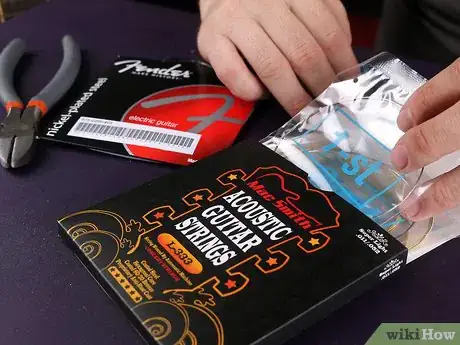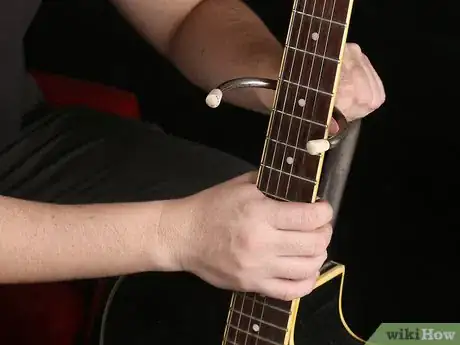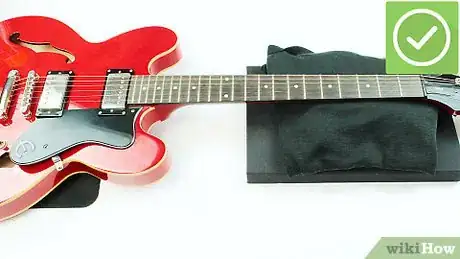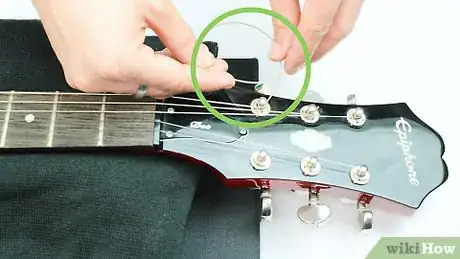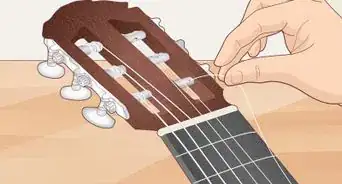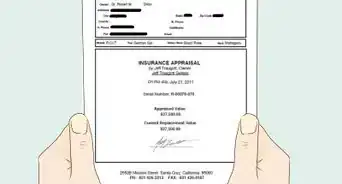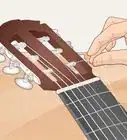wikiHow is a “wiki,” similar to Wikipedia, which means that many of our articles are co-written by multiple authors. To create this article, 54 people, some anonymous, worked to edit and improve it over time.
The wikiHow Video Team also followed the article's instructions and verified that they work.
This article has been viewed 4,541,635 times.
Learn more...
Whether you’re a beginner or guitar virtuoso, learning how to restring your instrument can be a helpful skill. While an electric guitar will need restringing more frequently than an acoustic guitar, restringing a guitar is essential to ensuring proper sound quality. Before you jam out or play your love an original ballad, be sure to keep your strings maintained and in tune.
Steps
Preparing to Restring your Guitar
-
1Find a clean and quiet place to restring your guitar. Keep the area clean so you don’t lose any tools. Similarly, find a quiet area so you can tune your guitar without having to listen to any background noise.[1]
-
2Gather your equipment. You will need a tuning machine, new strings, wire cutters, and a string winder. Depending on whether you’re a beginner or expert, you may not need a tuning machine if you are a seasoned musician able to tune instruments by ear.Advertisement
-
3Balance the neck of your guitar. Find something to secure the neck of your guitar like a special piece of equipment you can buy at a guitar store. If you are a beginner, you can also just use something soft and curved like a piece of polystyrene.[3]
Restringing an Acoustic Guitar
-
1Loosen the tension of each string with a tuning key and remove. Turn the tuning key and feel the tension loosen for each string. Once loose, unwind the string off of the tuning post and remove.[4]
-
2Remove the bridge pins from out of the bridge. Use the built-in notch of the string-winder to remove each pin. Once the pin is out you can also remove the string from the bridge of the guitar.
- Secure the ball end of the string against the underside of the bridge to sustain tone. Do not let the ball end sit on the tip of the pin or it will work itself loose.
-
3Place the string and bridge pin through the 6E bridge hole. Face the groove of a bridge pin toward the sound hole of the guitar and slide the pin into the hole together with the string. Simultaneously pull on the string with your other hand and as you push the pin through the hole and into place.
-
4Take the string through the tuning post and pull. Tighten the string as you push it about 3 inches through the tuning post. The string should be pulled towards the bridge.[5]
- About 2 inches from the corresponding machine head, cut the string so that you can poke it through the machine head shaft.
-
5Wind up the string using a string winder. Tighten the string by using the string winder on the appropriate tuning key but don’t look to tune at this time. Just tighten the string to ensure you have set it correctly.[6]
-
6Tighten the rest of the strings. Usually, it is best to tighten the strings in the order of: 5A, 4D, 3G, 2B, 1E.[7] Stretch your strings to ensure that they are correctly set.
-
7Tune your guitar. Most beginners will need to tune their strings several times with a tuning machine. Consult your local music shop if you are having difficulty using a tuning machine.[8]
-
8Cut any excess string using wire cutters. Loose wire can be dangerous and make it difficult to play your guitar. Cut any excess wire to ensure easy hand movement.
Restringing an Electric Guitar
-
1Ensure your guitar is at a stable position. Use a guitar support for the neck of your guitar as you lay it on a flat and solid surface. If you don’t have a guitar support, place the neck securely against your torso as you unwind the strings.
-
2Use wire cutters to sever the strings. Create some slack and cut the strings either by the midpoint of the body of your guitar or by the neck pickup. Once cut, remove the string.
- Make sure you do not drop the guitar.
-
3Take the new string and place it through the guitar. In a Gibson style guitar, take the new string through the tailpiece that is underneath the body. For a non-locking Fender-style, thread the new string into the tremolo cavity.
-
4Make the hole in the post align with the neck. Using the tuning key, turn the hole in the post perpendicular to the neck of your guitar.
-
5Tighten the string 3 inches from the bridge. As you pull the string, measure approximately 3 inches of slack to allow for winding. Keeping your thumb on the other side of the hole, stop threading the string through the post once it hits your thumb.
-
6Twist the string in an S shape. Use one hand above the post and the other below it to twist an S around the post. Smoothly twist the string in a clockwise motion.
- Twist in the opposite direction for high strings on 3 + 3 headstocks.
-
7Slide the string between the nut and the post. Wrap the part of the string that’s already through the post, around the post and between the excess string between the nut and the post. In other words, take the top part of the S and turn it into a P and place it through the bottom part of the S.
-
8Create a loop and crimp. Loop the two ends of the string, crimp, and tighten toward the top of the headstock. Tighten and lock the string into place with this technique.
-
9Use your thumb to anchor the lower part of the string and tighten. Take a string winder and place it on the tuning key. Turn clockwise and, just below the post, use your thumb to feel the string get taught.
-
10Stretch the strings as you tune. Repeat this process as needed. Use the 5th fret to start this process. Pull the string up with one hand and move up the fretboard with the other. Retune the other frets.
- The string will give as you stretch. Repeat the process until the string no longer slips.
- Remove excess string with wire cutters once you’re satisfied with the stretching.
-
11Finished.
Community Q&A
-
QuestionCould I use the same strings I took out if I was only taking them out so I could replace the broken one?
 Community AnswerYou could, but it's best to replace all the strings, especially if they're old. Mixing old strings with new strings, or different types of strings, would likely sound bad/different.
Community AnswerYou could, but it's best to replace all the strings, especially if they're old. Mixing old strings with new strings, or different types of strings, would likely sound bad/different. -
QuestionIs there something that I can use for my fingers that I can use for protection to avoid pains while playing guitar?
 Community AnswerPain in your fingers is normal when you first start playing. Over time, your finger pads will develop callouses that will protect them. Just be patient and stop when you need to.
Community AnswerPain in your fingers is normal when you first start playing. Over time, your finger pads will develop callouses that will protect them. Just be patient and stop when you need to. -
QuestionAre nylon strings easier on your fingers?
 Community AnswerIt is a matter of personal experience and preference, but they should be a little bit easier on your fingers.
Community AnswerIt is a matter of personal experience and preference, but they should be a little bit easier on your fingers.
Things You'll Need
- Guitar strings (electric or acoustic depending on which type of guitar you are restringing)
- Wire cutters
- Tuning Key
- Guitar tuner
- Bridge pin remover (Wire Clippers)
- String winder
Warnings
- Make sure you use the proper guitar strings depending on your type of guitar. Electric and acoustic guitars do not use the same strings.⧼thumbs_response⧽
- Electric guitar strings are lighter and corrode faster than acoustic guitar strings so you will need to restring them more frequently.⧼thumbs_response⧽
References
- ↑ http://www.ultimate-guitar.com/lessons/for_beginners/how_to_restring_a_guitar_a_step_by_step_guide.html
- ↑ http://www.ultimate-guitar.com/lessons/for_beginners/how_to_restring_a_guitar_a_step_by_step_guide.html
- ↑ http://www.ultimate-guitar.com/lessons/for_beginners/how_to_restring_a_guitar_a_step_by_step_guide.html
- ↑ http://www.ultimate-guitar.com/lessons/for_beginners/how_to_restring_a_guitar_a_step_by_step_guide.html
- ↑ http://www.ultimate-guitar.com/lessons/for_beginners/how_to_restring_a_guitar_a_step_by_step_guide.html
- ↑ http://www.ultimate-guitar.com/lessons/for_beginners/how_to_restring_a_guitar_a_step_by_step_guide.html
- ↑ http://www.ultimate-guitar.com/lessons/for_beginners/how_to_restring_a_guitar_a_step_by_step_guide.html
- ↑ http://www.ultimate-guitar.com/lessons/for_beginners/how_to_restring_a_guitar_a_step_by_step_guide.html
About This Article
To change guitar strings, start by loosening the old strings and removing the bridge pins. Next, insert the knob end of the new string into the peg hole, stretch it up to the appropriate tuning peg, and thread the end through the hole in the peg. Pull the string tight, turn the tuning key, and wind the string several times around the peg. Once the new strings are in place, tune your guitar and snip off the excess strings with wire cutters. To learn the differences between changing strings on an acoustic and an electric guitar, keep reading the article!

